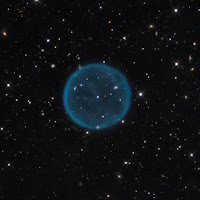 |
| Hercules. This Hero of Greco-Roman myth gives his name to the Hercules Family of constellations. |
Hercules is the genitive constellation of the large and diverse Hercules Family of constellations. Hercules is among the largest of the 88 constellations in the sky. The asterism represents a warrior at battle and is comparable in outline and overall size to Orion, though Hercules is a much dimmer constellation, having no First or Second Magnitude stars.
 |
| The dumbbell-shaped galaxy called Hercules A is being attenuated by a supermassive black hole within its bright center. |
The constellation Hercules became Hercules rather late in Classical Greek astronomy. Prior to identifying it with Heracles of yore, the Greeks considered it the figure of a standing man, but had no real lore about it.
The constellation was known to the Sumerians who considered nearby Draco The Dragon (or Serpent) part of the same figure. They linked Hercules / Draco with Ophiuchus / Serpens, calling the former "The Standing God" and the latter "The Sitting God" though the significance of the relative positions of the two gods and serpents is long forgotten.
Hercules' lower body is formed by the "Keystone" asterism, a rhomboid star pattern that makes this less-than-impressive constellation easier to locate.
 |
| The Hercules asterism. The keystone is self-evident. |
The Solar Apex, which indicates the actual direction of the Sun's orbital motion around the center of the Milky Way is located in Hercules. There are many multistar systems in Hercules that can be seen with binoculars or a small telescope. At least fifteen stars in the constellation can boast of solar systems. There are a number of Messier objects, galaxies, globular clusters, and nebulae, within the bounds of Hercules.
 |
| Abell-39, a spherical nebula in Hercules. |
 |
| The Great Wall is incredibly vast and pours prodigious amounts of raw energy into the heavens. |

No comments:
Post a Comment